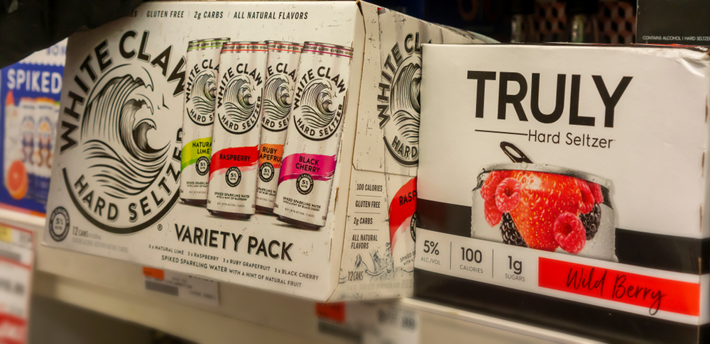More Alcoholic Beverages to Choose From Equals More Alcohol Consumption

The alcohol market is expanding. A lot of people don't drink, not because they have something against alcohol necessarily, but simply because they don't like the taste of alcohol. Yet it seems as though alcohol companies are trying to broaden their target audience by innovating new ways to get more customers.
Just this past summer, a beverage called “White Claw” was all the rage. White Claw is essentially flavored alcoholic seltzer water. Apparently, I was more than a little bit behind the times in alcohol innovations because I envisioned a novel by Jack London rather than a new alcoholic beverage.
So I did some digging and found that White Claw is not the only new twist on alcohol diversification. One can now easily find alcoholic juices, ciders, and lemonades on grocery store shelves. Even alcohol-spiked coffee is becoming more popular. To me, this looks like it is the alcohol industry’s effort to broaden their target audience, to get more customers, to turn people who wouldn't normally drink into people who now definitely drink. Alcohol corporations innovate new drinks, attempting to make otherwise sober Americans into customers.
But what does that mean for the health of the nation?
New Twists on the Same Old Story
Alcohol companies are innovating new products, but that's nothing new. While they way these drinks taste may change along with how they are marketing. All types of alcohol, even though they might look and taste different, are going to have the same effect on those who consume them, i.e., drunkenness, a degree of harm to the body, potentially poor decision-making, next-day hangovers, etc.
In the last few years, we’ve seen a significant surge in the “alt-alcohol” market. Rather than just trying to sell beer, wine, and liquor, alcohol manufacturers are broadening their product offering in order to capture a potential customer base that does not like the taste of beer, wine, or liquor.
In the last few years, one of the products with an upsurge in the sale and consumption is hard seltzer. We’ve also seen increases in the sale and use of hard lemonades and juices. Even alcoholic cider, traditionally thought to be more of a seasonal beverage, is growing in annual sales and consumption.
And while these new products may help the companies bottom line, they do little to help those suffering from alcohol addiction. Instead, alcohol corporations are diversifying, trying new things, and attempting to carve out new markets and get more people interested in drinking.
But that’s not necessarily the right or proper thing to do, especially considering how much of a drinking problem our country already has.
Alcohol Risk – A Look at the Statistics

It does not take a lot of heavy reading and in-depth research to see how much our country struggles with alcohol. Just a quick look at some brief statistics, cited directly from the National Institute on Alcohol Abuse and Alcoholism (NIAAA), shows us exactly how harsh this problem has become:
- “In 2017, 26.4 percent of people ages 18 or older reported that they engaged in binge drinking in the past month; 6.7 percent reported that they engaged in heavy alcohol use in the past month.”
- “According to the 2017 National Survey on Drug Use and Health (NSDUH), 14.1 million adults ages 18 and older (5.7 percent of this age group) had AUD [Alcohol Use Disorder]. This includes 9.0 million men (7.5 percent of men in this age group) and 5.1 million women (4.0 percent of women in this age group).”
- “An estimated 88,000 people (approximately 62,000 men and 26,000 women) die from alcohol-related causes annually, making alcohol the third leading preventable cause of death in the United States. The first is tobacco, and the second is poor diet and physical inactivity. In 2014, alcohol-impaired driving fatalities accounted for 9,967 deaths (31 percent of overall driving fatalities).”
- “In 2010, alcohol misuse cost the United States $249.0 billion. Three-quarters of the total cost of alcohol misuse is related to binge drinking.”
The research from the NIAAA discusses how alcohol consumption costs the U.S. hundreds of billions of dollars annually, and that the majority of those costs come from alcohol misuse. Furthermore, the research talks about the familial implications of alcohol misuse, citing the fact that more than ten percent of U.S. children live with a parent who has a drinking problem.
Profits Without Responsibility Spell Disaster
As the alcohol market continues to expand, a considerable share of the responsibility of preventing alcohol addiction rests not only on the companies making profits, but also on the shoulders of the American people. We have to get educated and informed about the harmful effects of drinking. If we are in recovery from drug or alcohol addiction, we shouldn’t drink at all.
And alcohol companies are even providing a nonalcoholic option for people who like the taste of alcoholic beverages, but who don’t want to consume any alcohol. An article in Esquire lists options for tasty drinks that have zero alcohol in them.
As for diversifying and working to target a more extensive customer base, I’d like to see more effort on behalf of alcohol companies taken towards offering more nonalcoholic options.
Seeking Help for an Alcohol Problem

If you know someone who struggles with a drinking problem, you must help them get into a residential treatment center as soon as possible. Alcohol use can be a life or death matter. We know that from the 88,000 people who die from alcohol-related causes every year. Don’t let your loved one become a statistic. Residential, long-term drug and alcohol treatment centers offer the safest and most successful programs for helping people break free from addiction.
Sources:
- https://daily.sevenfifty.com/whats-fueling-the-rapid-growth-of-hard-seltzer/
- https://www.bevindustry.com/articles/91265-mikes-hard-lemonade-accelerates-growth
- https://www.forbes.com/sites/taranurin/2018/05/31/hard-cider-sales-rebound-after-two-years-of-declines/
- https://www.niaaa.nih.gov/publications/brochures-and-fact-sheets/alcohol-facts-and-statistics
- https://www.esquire.com/food-drink/drinks/g1569/good-alcoholic-beers/


 ®
®